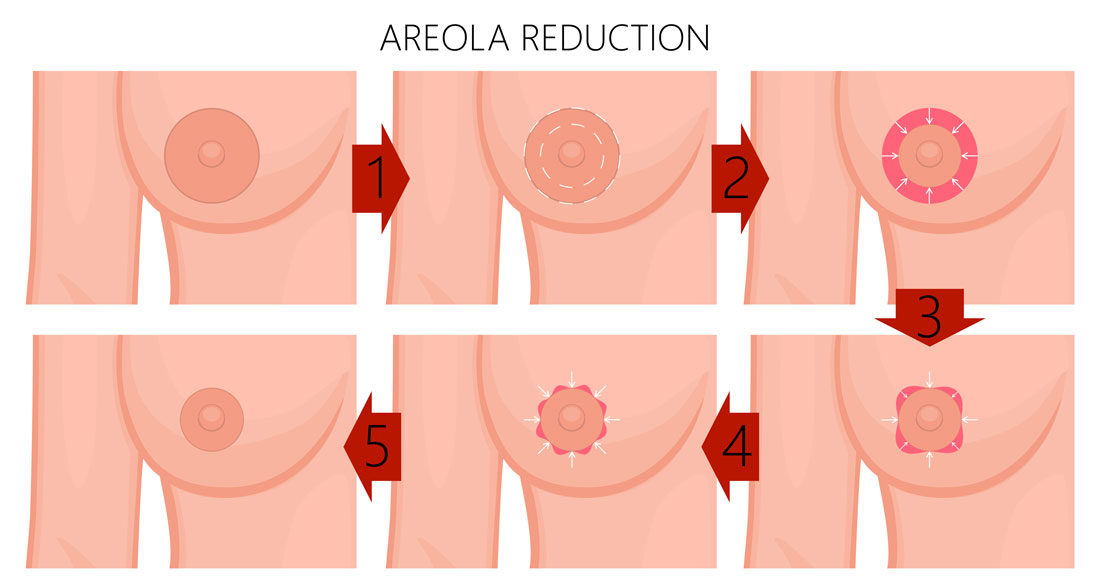What you need to know about Areola Reduction
Contents
Areola reduction is a surgical procedure to permanently decrease the diameter of one or both of the areolas (the pigmented area that surrounds the nipple). There are no medical reasons to undergo an areola reduction. This procedure is an option for women or men who are not happy with the size of their areolas or how their areolas look. It works well with people who:
-
Are born with areolas that are subjectively large
-
Have stretched areolas due to significant weight loss
-
Have protruding or puffy areolas
-
Experience a significant change in their areolas after pregnancy, breastfeeding, or trauma
-
Have asymmetrical areolas (the procedure can reduce one to match the other)
-
For any other reason, do not like the way their areolas look and feel self-conscious about it.
Areola reduction can be performed on its own or together with other breast enhancement procedures, such as breast augmentation, breast reduction, breast lift, or nipple reduction.
What does the Procedure Involve?
Before areola reduction begins, an anesthesiologist will give you a local anesthetic. With this type of anesthetic, you will be awake but the affected area will be numbed, so you will not feel any pain. In some cases, you will be given general anesthetic instead, which will put you to sleep.
Next, your doctor will create a circular incision along the perimeter of your areola, where the surgical scar can be more easily hidden, and cut out any extra tissue. Then, the new shape of your areola will be secured with a permanent suture inside your breast. This suture can prevent your areola from stretching. Finally, dissolvable or removable stitches will be used to close the incision site and your surgeon will bandage the area. You will also be fitted with a special post-surgical bra.
How Long Should I Stay in the Area?
You should be able to leave the hospital on the day of surgery. Still, it is advisable that you stay in the area for 2 to 3 days to let your body recover before traveling home. Some surgeons may also schedule a follow-up checkup to monitor your healing and remove your stitches (if removable stitches are used). In this case, you may need to stay for a week.
What’s the Recovery Time?
Areola reduction has a relatively quick recovery time. You may experience some bruising and swelling for the first few days following your surgery, but you can usually go back to work within a day or two if you have an office job. However, it is important to remember that you need to avoid intense activities, such as exercise and heavy lifting, for at least 3 weeks following your surgery.
What About Aftercare?
Your surgeon will give you post-operative instructions, which include restrictions on activity and how to take care of your surgical wounds. Here are a few things that might be included in the instructions:
-
Take pain medicine as prescribed to help with the pain and discomfort that you may feel during the first couple of days of surgery. If your surgeon does not prescribe pain medication, you can take over-the-counter pain medications, such as ibuprofen (Advil).
-
Ask a friend or family to help you during the initial recovery period because you will need help moving around. Even simple tasks can be quite difficult on the first day or two following your surgery.
-
Sleep on your back during the first week of your recovery to avoid injuring or putting excess strain on your chest.
-
Wear a post-surgical bra or a soft sports bra for at least two weeks. These can protect the area and position your nipples for optimal healing. Tell your medical team if your post-surgical bra is too tight as it can lead to healing complications.
-
Avoid sex for about a week.
-
Avoid physical chest contact for about three to four weeks following your surgery.
What’s the Success Rate?
Areola reduction is a very safe procedure. Since it is a relatively simple cosmetic procedure, the success rates are very high and most people who have the procedure reported that they are satisfied with the results. It is important to note, however, that it may take a few weeks before you can appreciate the results. The results can be obscured by the initial period of bruising and swelling.
Like all surgeries, areola reduction also comes with potential risks. These include:
-
Scarring
-
Loss of sensation in the nipple
-
Inability to breastfeed
-
Infection.
In some cases, the areola can stretch and widen with time back to its original size, due to aging, hormonal changes, or breastfeeding.
Are there Alternatives to Areola Reduction?
There are actually not many alternatives to areola reduction surgery. However, you may opt for injectable fillers (such as Restylane, Juvéderm, and Radiesse) or fat transfer if you want to make your areolas appear more symmetrical or if you want to add support or volume to the area.
What Should You Expect Before and After the Procedure
Before you undergo areola reduction, you may not like the appearance of your areola and you feel self-conscious about it. After the procedure, the appearance of your areolas will be altered to the way you want it to be. For instance, if your areola is big, it will be smaller after the procedure. If your areolas were asymmetrical, your surgeon will make it more symmetrical. This will give you a huge confidence boost.
For an in-depth analysis of an Areola Reduction Procedure, watch this short video.
To check prices or to book an Areola Reduction Procedure, in Thailand or anywhere else in the world, head on over to MyMediTravel now!


